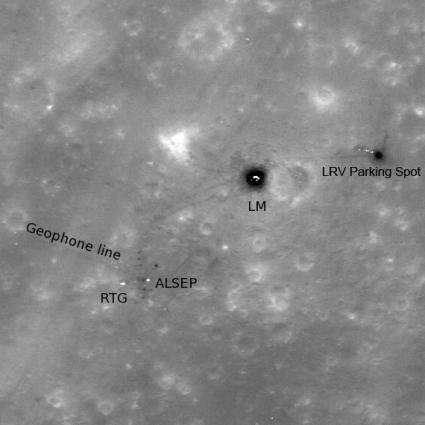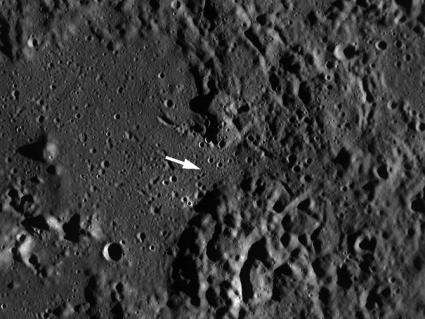Image: Apollo 16: Footsteps Under High Sun

(PhysOrg.com) -- The lunar module Orion landed in the Descartes Highlands of the moon on April 21, 1972. The Apollo 16 mission targeted a highland region. Originally thought to be a volcanic site, the samples returned by Apollo 16 actually indicated that the highlands of the moon primarily consist of impact-formed rocks (breccias), a substantial scientific result.
Today's featured image is an LROC NAC image of the Apollo 16 landing site, acquired when the sun was nearly overhead, in contrast to a previous image of the site. High sun causes white and metallic artifacts left on the surface by Young and Duke to stand out in high contrast as they reflect the noon-day sun back at LROC. The Apollo 16 astronauts churned up the lunar soil (regolith) as they moved about exploring the moon, and this disturbed material shows up as dark lines and patches. Since the astronauts spent a fair amount of time around the Lunar Module during their three extra-vehicular activities, the bright lunar module appears to have a dark halo. The same dark halo appears around the parked rover.

This location has been identified as a region of interest because many important scientific questions could be answered by studying it. For example, like other Apollo landing sites, the artifacts left at the Apollo 16 site provide a record of space weathering at the site since 1972. Various planned (and accidental) long duration exposure experiments (like NASA's Long Duration Exposure Facility, experiments on Mir, etc.) have been studied, but all of these have been from facilities in low-Earth orbit. Studying what decades of exposure to the lunar environment does to hardware will provide key inputs to engineers designing future systems to operate for long periods in extra-terrestrial environments, such as the moon, Mars, asteroids and others.
The Apollo 16 site also provides access to highlands regolith and rocks; highlands rocks make up about 70 percent of the lunar surface, and this landing site would be a great place to study additional samples that would help us characterize the materials that comprise the majority of the lunar surface.
Provided by JPL/NASA




















